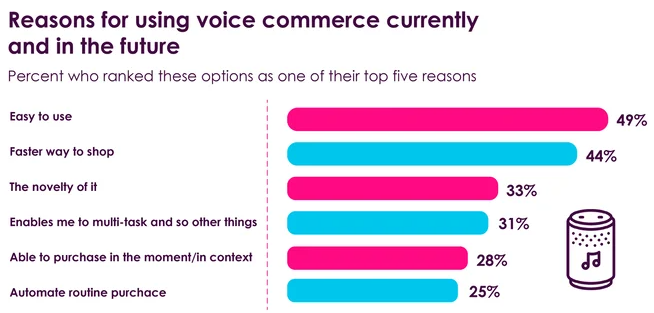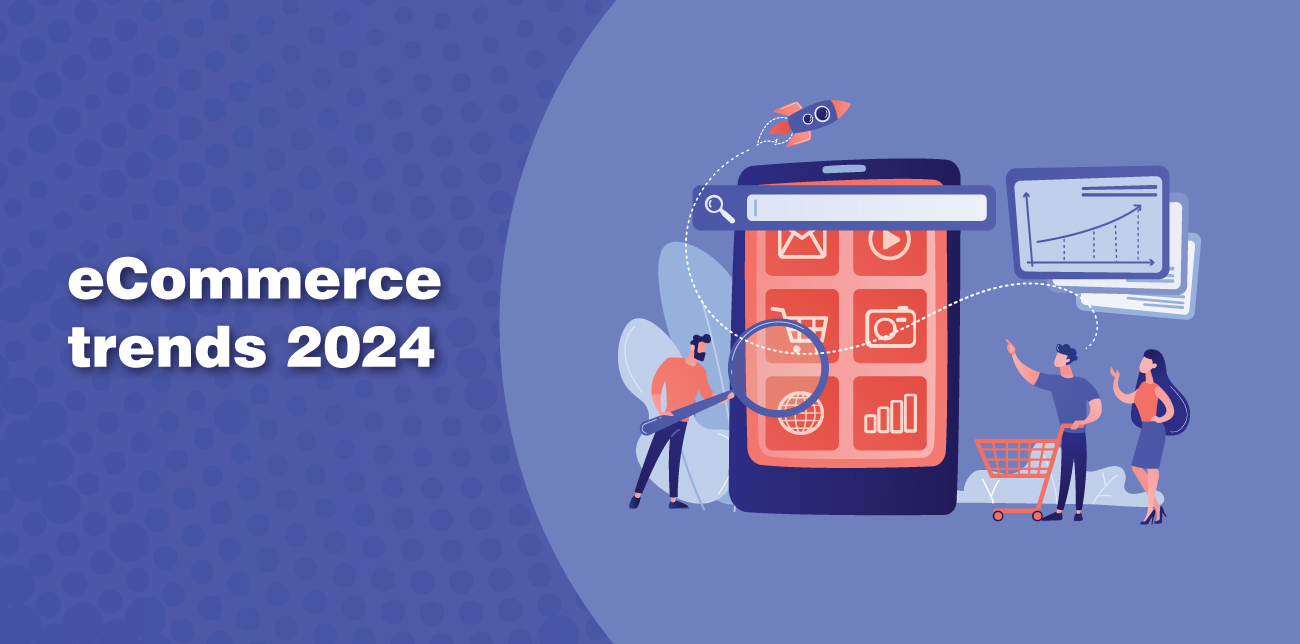As we are about to enter 2024, staying in touch with the latest eCommerce trends is paramount, especially for retailers and industry leaders wishing to advance in this volatile market. In this never-ending fight, the integration of cutting-edge technologies accelerates overall technological advancement and catalyzes bringing brands closer to consumers. By understanding and incorporating these trends, businesses can leverage hyper-personalization strategies and employ omnichannel engagement, creating a seamless and immersive customer experience. The article seeks to empower readers with insights into the transformative capabilities of emerging technologies, equipping them with the knowledge needed to stay competitive in an era where innovation is crucial to success in the dynamic world of eCommerce and retail.
Table of Contents
The top 10 eCommerce trends in 2024
As we venture into 2024, the eCommerce landscape is poised for transformative changes driven by technological advancements. From the integration of artificial intelligence and the rise of automation and chatbots to the evolution of omnichannel, AR, and VR strategies, these trends promise to reshape how businesses engage with consumers. Moreover, emerging means in the industry involve social commerce, livestream shopping, and sustainable practices, to name a few. Stay ahead of the curve by delving into the dynamic world of the hottest eCommerce trends, where staying informed is not just a strategic choice but an imperative for sustained success.
Trend #1: Augmented reality on customer experience can increase sales by 40%
The adoption of augmented reality (AR) in retail represents a cutting-edge best practice, especially considering the remarkable growth projected in the AR hardware market, with a staggering 126.7% compound annual growth rate (CAGR) in 2023. Additionally, the global VR/AR market experienced a 77% CAGR from 2019 to 2023, underlining the bright future for this innovative technology. The anticipation of 1.73 billion mobile AR users by 2024, up from 800 million in 2021, further emphasizes the expanding influence of AR in the consumer landscape.
Consumers are increasingly drawn to AR, particularly when shopping and gaming. The rise of mobile AR devices, such as smartphones, has empowered individuals to leverage AR technology to enhance their shopping experiences significantly. Whether virtually trying on clothes or visualizing furniture in their own spaces before making purchase decisions, consumers are embracing AR as a tool to make more informed choices.
Businesses that integrate AR into their retail strategies are witnessing tangible benefits. The interactive and personalized experiences that AR provides bridge the gap between online browsing and physical stores. Brands offering AR-enabled shopping experiences report increased engagement, higher conversion rates, and enhanced customer satisfaction. This fact is reinforced by studies indicating that companies incorporating AR into their e-commerce strategies experience a notable boost in conversion rates, up to 40%.
AR doesn’t just stop at personalization; it also enables brands to foster deeper engagement by bringing products or services to life in innovative ways. Through interactive 3D models or virtual try-on features, customers can visualize and interact with products before making a purchase decision, creating a sense of excitement and involvement.
Moreover, AR contributes to reducing product returns and improving customer satisfaction by providing buyers with a realistic preview of the products they intend to purchase. As AR technology advances, we can anticipate even greater improvements in e-commerce sales, making it a transformative force in the retail industry. In essence, leveraging AR is not just a trend; it’s a strategic imperative for brands seeking to stay competitive and resonate with the evolving preferences of today’s consumers.
Trend #2: Voice search for shopping enters the race in the latest eCommerce trends – 43% of smartphone users love it

Voice search, a speech recognition technology allowing users to search the Internet by speaking, is a pivotal development in eCommerce. Prominent examples include Amazon Alexa, Apple’s Siri, and Google Voice, collectively facilitating voice interactions and communication. Remarkably, 50% of all searches are now voice-activated, with 72% incorporating voice search into daily routines and 43% of smartphone users utilizing it for shopping. These statistics underscore the significance of voice search as one of the fastest-growing eCommerce trends in 2023. Beyond convenience, voice search enhances accessibility for individuals with visual impairments and those requiring fine motor skills.
Despite being in its infant stages, its popularity is swiftly rising due to its dual benefits of convenience and accessibility. Businesses are recognizing this trend even more, with 91% of surveyed companies investing significantly in voice search in 2018 and 94% planning to increase their investment the following year. The optimism for the voice shopping market is substantial, with Juniper projecting a market value of $80 billion in 2023.
Retail leaders can seize the opportunities presented by voice search but must also comprehend the challenges it poses for driving commerce. Understanding that middle-aged adults (25-49 year-olds) are the primary users of voice search in their day-to-day experiences, especially at home, provides valuable insights for eCommerce optimization. Targeting this demographic is a strategic tip for enhancing your eCommerce strategy and embracing the latest best practices in the evolving landscape of retail.
Trend #3: AI personalization still goes strong in the eCommerce trends game – 71% of consumers expect companies to deliver personalized interactions
Personalization in retail has evolved from an optional asset to an essential strategy for distinguishing brands in the competitive e-commerce landscape. Consumer expectations are rising, with 73% anticipating brands to understand their unique needs. This trend involves tailoring experiences across various channels, including live chat, websites, emails, mobile apps, in-store interactions, call centers, and social media. Effective personalization includes tactics such as product recommendations based on purchase history, personalized rewards aligned with individual interests, and even facial recognition in physical stores. An omnichannel strategy is crucial as shoppers engage with brands across multiple platforms, and the lack of personalization can lead to customer loss, as evidenced by 62% expecting and wanting personalized experiences.
With the impact of personalization being significant, 49% of consumers express a likelihood to become repeat buyers if offered a personalized experience. Brands not embracing personalization risk losing customers, as 62% now expect this level of customization. While consumers desire personalization, they also prioritize privacy, and brands must respect this balance to maintain customer trust.
Looking ahead, artificial intelligence and machine learning will play a key role in personalization efforts, particularly in providing product recommendations based on past data. Brands are increasingly relying on first-party data collection methods, such as loyalty programs and customer surveys, to respect privacy concerns and fill the gap left by third-party cookies. As more consumers shop on mobile devices, brands leveraging behavior analytics and customer data for personalized mobile app experiences can enhance relevance and convenience. Mobile app notifications, offering limited-time sales, promotions, and order updates, contribute to a more tailored and engaging shopping experience.
Trend #4: Sustainable commerce – 62% of consumers are willing to change their purchasing habits to reduce environmental impact
Lately, more and more consumers favor companies aligned with their values, with 46% expressing a higher likelihood of purchasing from those actively engaged in charitable donations. Corporate responsibility is no longer just rhetoric; it significantly impacts consumer choices, prompting a surge in eCommerce stores prioritizing sustainable practices in sourcing, packaging, and manufacturing, a trend expected to gain momentum in 2024.
In a bid to promote sustainability and reduce waste, a notable trend is the rise of e-commerce during the holiday season. Both businesses and consumers embrace concepts like buying secondhand and engaging in reusing and reselling. Famous brands like Lululemon are already pioneering initiatives such as “Lululemon Like New,” encouraging the purchasing and selling of pre-loved items, which sets the stage for a more eco-conscious shopping future.
This shift mirrors an increasing awareness of the environmental impact of consumerism, and major brands have started to align with this trend, demonstrating a commitment to sustainability and the circular economy. With 76% of global consumers prefer retailers that ethically source services and materials, businesses embracing eco-friendly options can attract consumers seeking quality products and positive environmental impact.
Small retailers can leverage this by adopting approaches like Lululemon’s, offering like-new, resold items at promotional discounts. This tactic can be executed through online storefronts, in-store “resale clearance” racks, or other innovative ideas specific to their business and industry. Striking the right balance between used, and new items involves gauging local thrift store activity, and consignment stores, and engaging customers to align with demand and preferences, ensuring a data-driven strategy.
Trend #5: The omnichannel revolution will support the phygital retail – 56% of shoppers need to see and touch their favorite products before purchasing
The future of eCommerce is evolving towards phygital, seamlessly combining online channels with physical retail experiences. This progressive eCommerce model integrates diverse channels and platforms, fostering hybrid commerce or omnichannel selling. One effective omnichannel strategy is the implementation of click-and-collect, also known as “buy online, pick up in-store” (BOPIS). This service enables customers to complete online purchases and conveniently collect them at the store or a designated pickup point.
The click-and-collect trend is steadily growing, driven by the convenience of online shopping, swift in-store visits, and the elimination of shipping charges. Its anticipated value is set to surpass $154 billion by 2025, with major retailers like Walmart, Target, and IKEA already adopting this service. In tandem with this, the “research online-purchase offline” (ROPO) consumer behavior has gained popularity. Apart from zero shipping fees, ROPO allows customers to ensure a product’s compatibility, reflecting the desire of 56% of shoppers to physically interact with products before buying. For eCommerce businesses, incorporating a progressive web app (PWA) is a strategic choice to cater to online shoppers. PWAs, acting like native apps, compatible across various devices and browsers, optimize the mobile shopping experience.
Even with a robust eCommerce app or site, expanding to online marketplaces is advisable. Global online marketplace sales are projected to reach $8.8 trillion by 2025 at a 20% CAGR. Leveraging marketplace benefits such as free shipping and return policies can attract consumers. Crucially, maintaining a consistent customer experience across online and offline channels is paramount. This commitment yields significant returns, with companies implementing omnichannel campaigns experiencing a 494% higher order rate.
Trend #6: Social commerce and livestream shopping – estimations show that the live commerce market will reach $35 billion in sales volume by 2024
Live commerce, or livestream e-commerce, employs digital video content for real-time product promotion and sales. This digital format, unlike traditional home shopping TV, enables interactive communication, allowing users to instantly make purchases during broadcasts. Originating from China, live shopping gained significant momentum during the COVID-19 lockdowns, reaching a gross merchandise value (GMV) of 3.5 trillion yuan in 2022—eight times its pre-pandemic value. Forecasts predict sustained growth, with live-streaming commerce expected to constitute a quarter of all GMV online shopping in China by 2023.
Live commerce, a fusion of social media and eCommerce, is not limited to China; it’s rapidly gaining traction globally. Platforms like TikTok are poised to transform into modern home shopping channels, presenting exciting opportunities for eCommerce, especially during the holiday season. The integration of shipping and logistics within TikTok’s shopping solution is set to make it more akin to Amazon’s business model than Meta’s.
The appeal of live video shopping lies in its real-time engagement features, allowing retailers and influencers to showcase products, offer exclusive deals, and interact directly with audiences. This trend is expected to revolutionize consumer-business interactions, particularly drawing in younger consumers with its interactive and entertaining shopping experiences.
Also known as livestream shopping or live video shopping, live commerce offers a unique blend of unlimited audience reach and personalized interactions. Viewers can engage, ask questions, and interact with influencers through live chat channels, creating a more personalized shopping experience. The industry’s exponential growth, estimated to reach $600 billion in China and $25 billion in the US by 2023, highlights its transformative impact on the eCommerce industry.
While the Chinese platform Taobao leads in live shopping, global platforms like Facebook, Instagram, and TikTok, as well as e-commerce giants like Amazon, are also embracing this dynamic trend. The convergence of social and live commerce emerges as a best practice, reshaping the way businesses engage with consumers and drive e-commerce sales.
Trend #7: Buy now, pay later is the next big thing in eCommerce trends – 63% of shoppers are more inclined to opt for a retailer offering their desired payment methods
Buy Now, Pay Later (BNPL) represents a credit form allowing consumers to divide retail transactions into interest-free installments for gradual repayment. The BNPL sector has experienced remarkable growth, with U.S. loan originations increasing by 970% from 2019 to 2021, reaching 180 million transactions. The Gross Merchandise Volume (GMV) associated with these transactions surged by 1,092%, from $2 billion to $24.2 billion.
Flexible payments, particularly popular among millennials and Gen Z, constitute one of the swiftest-growing segments in digital sales. This trend is accentuated by the fact that 67% of young buyers lack credit cards. The adoption of alternative payment methods, such as BNPL, is on the rise, evidenced by 34% of UK shoppers using the service during the 2022 Christmas period. Considering that Gen Z and millennials are projected to comprise 70% of the U.S. population by 2028, retailers need to recognize the impact of these demographics on shaping future retail trends. Even mature cohorts, predominant in current retail spending, are embracing BNPL, as higher-income individuals within older generations are expanding their usage.
Retailers must acknowledge the diverse payment preferences of their customer base to remain competitive. Failure to offer alternative payment methods like BNPL can lead to missed opportunities and potential loss to competitors. Providing a variety of payment options is not only customer-centric but also crucial for increasing conversion rates, especially on mobile devices.
Trend #8: Chatbots can increase eCommerce revenue by 7-25%, making for a no-brainer solution in 2024
A chatbot is a software designed to simulate human-like communication through chat interfaces. This technology serves diverse purposes, engaging potential customers, capturing contacts, handling simple queries, and introducing services by highlighting key features. The global chatbot market is projected to reach $994 million by 2024, reflecting its increasing integration into marketing and customer support processes.
With 1.3 billion users on Facebook Messenger, leveraging chatbots and their benefits for marketing, customer service, and sales aligns with the vast user base. Chatbots provide nearly instant support, connecting users to the right department when needed.
Despite some preferring traditional phone support, 62% of consumers favor engaging with a chatbot over waiting 15 minutes for a human agent. Utilizing natural language processing (NLP), chatbots efficiently address basic problems and common queries, enhancing customer service. In a retail setting, chatbots go beyond mere customer support; they function as in-store personal assistants, aiding customers in locating products and expediting the overall shopping experience. Their versatility extends to supporting every stage of the customer journey, from the initial engagement that drives conversion to post-purchase interactions that foster customer retention.
Moreover, chatbots can seamlessly integrate into live chat protocols, responding to initial inquiries, organizing information, and routing customers to live agents when available. The integration of chatbots in retail reflects a broader trend toward personalized, efficient, and technology-driven customer interactions. As businesses continue to embrace these capabilities, chatbots and their best practices are positioned to play a central role in shaping the future of eCommerce and customer engagement strategies.
Trend #9: Subscription models and loyalty programs are solidifying long-term customer relationships
Prior to delving into personalized messaging, brands should prioritize cultivating customer trust. Establishing trust often precedes the optimal timing for personalized interactions, especially post-purchase or after a relational foundation is formed. Customer trust is a cornerstone for data sharing, with brands earning it through top-tier user experiences and reliable, accessible support services. Creating an environment where consumers feel confident in sharing their data enhances the potential for meaningful personalization.
Subscription models, offering diverse conveniences, have gained significant traction in the eCommerce landscape. They not only appeal to consumers for their practicality but also provide companies with a structured approach to inventory planning and secured sales. The subscription market is experiencing exponential growth, projected to achieve a remarkable 71% Compound Annual Growth Rate (CAGR), surpassing $2 trillion by 2028. Acknowledging the pivotal role of the subscription model in eCommerce growth, 70% of business leaders foresee its significance in the industry’s expansion.
However, mitigating churn rates emerges as a key challenge. To address this, enticing perks such as free delivery, reduced prices, and exclusive access to products can be instrumental. Effective communication, including updates on delivery delays, proves crucial in fostering customer trust and loyalty. Consumers, seeking convenience, value, and personalized recommendations, are increasingly embracing subscription services. Retailers are responding by offering a spectrum of subscriptions, ranging from personalized clothing and beauty products to meal kits. Brands strategically adopt subscription models to cultivate customer loyalty, enhance profitability, and bolster retention rates. Especially in times of economic instability and inflation, B2C brands position subscription plans as opportunities for savings, often with promises of lifetime price rates as incentives for registration.
Trend #10: The flexibility and agility of headless commerce systems are here to stay
In essence, headless commerce involves separating the front end and back end of an eCommerce application, providing brands with unparalleled flexibility in design, scalability, and functionality to enhance the customer experience. This architecture is characterized by its reliance on APIs, crucial for innovation by delivering new functionalities that engage customers and surpass their expectations.
In traditional eCommerce models, adapting to emerging touchpoints and experiences can be cumbersome, requiring updates to both front and back-end systems. Headless commerce, however, resolves this challenge, particularly benefiting larger enterprises with substantial development and IT teams. Typically, these businesses exhibit a do-it-yourself attitude, understanding the investment of development hours required for reliable custom programming of separate front-end and back-end systems. In a post-pandemic landscape that prioritizes digital-first shopping experiences, innovation becomes imperative, and headless commerce offers a strategic solution.
This approach allows eCommerce platforms to be entirely decoupled from the frontend presentation layer, attracting more businesses due to its backend flexibility and additional advantages in SEO, content marketing, and digital experiences. As the eCommerce industry evolves, the adoption of headless commerce emerges as a key trend, empowering brands to stay agile and responsive in a dynamic market.

Other rising eCommerce trends to consider
Trend #11: Operational agility
Operational agility is paramount, allowing businesses to swiftly adapt and respond to market changes, customer demands, and emerging trends to maintain a competitive edge.
Trend #12: ‘Multi-local’ commerce
Embracing a ‘Multi-Local’ approach in commerce involves tailoring strategies and offerings to diverse local markets, acknowledging unique consumer behaviors, preferences, and cultural nuances to create a more personalized and resonant shopping experience.
Trend #13: Owned channels and audiences:
Retailers are increasingly prioritizing owned channels, such as branded websites and apps, to build and engage with their audiences directly, reducing reliance on third-party platforms and cultivating stronger brand-consumer relationships.
Trend #14: Fast-format delivery
Fast-format delivery is a trend focused on providing swift and convenient product delivery, meeting the rising expectations of consumers for quick turnaround times and efficient fulfillment, often facilitated by local distribution centers and partnerships.
Trend #15: Localized fulfillment and last-mile sustainability
Prioritizing localized fulfillment centers enhances last-mile sustainability by reducing transportation distances, optimizing delivery routes, and minimizing the environmental impact of shipping, aligning with the growing demand for eco-conscious retail practices.
Trend #16: Customer service with direct messages (DMs)
In 2023, 19% of consumers have utilized direct messages (DMs) for customer service, reflecting a 45% increase from the previous year. Utilizing customer relationship management (CRM) software is crucial for efficiently managing interactions across various channels. Additionally, it’s essential to ensure that your customer service teams are well-trained to handle social media messages with professionalism.
Trend #17: Same-day or next-day delivery
Modern consumers not only desire swift delivery times, but they now anticipate them. In certain instances, customers are willing to pay extra for same-day or next-day delivery. Failing to provide these options may result in customers seeking alternatives from competitors who offer expedited delivery services.
Trend #18: Mobile-first shopping
Approximately 75% of online shoppers favor using their mobile devices, while only 15% opt for desktops and 6% choose tablets. With the increasing dominance of mobile purchasing, it is crucial to design an eCommerce site that is specifically optimized for mobile users. The integration of fingerprint and facial recognition technology, along with one-click payments, will streamline the mobile payment process, providing additional incentives for consumers to transition from desktop to mobile. As a result, mobile is poised to emerge as the favored payment method for eCommerce transactions soon.
Trend #19: Image search
As eCommerce shifts towards mobile platforms, businesses are exploring options that enable users to visually search for products using personal or online-found photos. The introduction of image search provides an avenue for discovering similar products at potentially lower prices online, potentially influencing consumers to transition from in-store shopping to online platforms. Some eCommerce enterprises, such as Pinterest, have already effectively integrated image search functionalities into their online interfaces.
Trend #20: First and zero-party data
In adapting to the latest data policy changes, businesses can navigate the challenge by prioritizing the collection of first and zero-party data, referring to information gathered directly from engaged and consenting customers. Various methods, such as quizzes, polls, and registration, can be employed to gather first and zero-party data. Beyond compliance, first and zero-party data not only provides valuable insights but also enhances customer engagement through a more participatory experience. It’s essential, however, to strike a balance and refrain from overwhelming customers by requesting excessive information all at once, ensuring a positive and sustainable data-gathering approach.
Key eCommerce trends & technologies per industry
Key eCommerce trends for the fashion industry
- Virtual Fitting Rooms leverage augmented reality to enhance the online shopping experience, allowing customers to virtually try on clothing items and accessories before making a purchase.
- Livestream Shopping is gaining momentum, with fashion brands increasingly turning to live video broadcasts to showcase products in real-time, engage with audiences, and drive immediate sales.
Key eCommerce trend for the pharmacy industry
- Telehealth Integration is becoming crucial in the pharmacy sector, facilitating online consultations, prescription orders, and remote healthcare services to meet the growing demand for digital health solutions.
Key eCommerce trend for the cosmetics industry
- Customized Product Creation is a rising trend, enabling customers to personalize and tailor cosmetic products according to their preferences, skin tones, and individual needs, fostering a more personalized beauty shopping experience.
Key eCommerce trend for the furniture industry
- 3D Room Planning Tools are transforming the furniture buying process, allowing customers to visualize how products will fit and look in their spaces through interactive 3D models, enhancing the decision-making process and reducing returns.
Key eCommerce trend for the grocery industry
- Automated Subscription Models are gaining popularity, streamlining the grocery shopping experience by offering automated, recurring deliveries based on customers’ preferences, ensuring convenience and regularity.
Key eCommerce trend for the toy industry
- Educational Integration is a prominent trend, with toy retailers incorporating educational elements into their products and online platforms, aligning with the growing demand for toys that promote learning and development in children.
Promising eCommerce trends “validated” in 2023
Case #1: Vevor

Specializes in selling industrial equipment and tools, ranging from kitchen appliances to woodworking machinery. Vevor’s growth pattern suggests that there is a robust market for specialized eCommerce platforms that cater to niche industries, offering a wide product range with user-friendly interfaces, secure payment systems, and efficient logistics.
Case #2: Neeman’s

A DTC footwear startup focusing on shoes made from natural fibers, highlighting a consumer shift towards sustainable and eco-friendly products. Their rapid growth can be attributed to the increasing demand for products that are not only functional but also environmentally responsible and health-conscious.
Case #3: OnBuy

An online eCommerce marketplace that focuses on creating a fair environment for both buyers and merchants. The platform’s growth indicates a market preference for transparent, equitable online marketplaces that offer a wide range of products at competitive prices, ensuring secure transactions without directly competing with their merchants.
eCommerce trends FAQs
What are the latest eCommerce trends that were nurtured during 2023?
During 2023, several key eCommerce trends gained prominence. Virtual fitting rooms and livestream shopping transformed the fashion industry, enhancing the online shopping experience. Telehealth integration became pivotal for pharmacies, providing remote healthcare services. Customized product creation and 3D room planning tools influenced the cosmetics and furniture sectors, offering personalized experiences. Automated subscription models gained traction in the grocery industry, streamlining regular deliveries. Educational integration became prominent in the toys industry, aligning with the demand for educational toys.
How can eCommerce trends boost sales?
eCommerce trends can significantly boost sales by enhancing customer experiences, and any trend that accomplishes that is a winner. Virtual fitting rooms and customized product creation create a personalized shopping journey, increasing customer engagement and satisfaction. Livestream shopping facilitates real-time interactions, driving immediate sales. Automated subscription models ensure customer loyalty and repetitive sales. Educational integration in the toy industry attracts parents looking for enriching products. These trends collectively contribute to a seamless, convenient, and personalized shopping environment, translating into increased sales and customer retention.
Are there risks in following eCommerce trends?
While adopting eCommerce trends is crucial for staying competitive, there are risks involved. Rapid changes may lead to oversaturation and heightened competition. Poorly executed trends may result in a disconnect with the target audience. Additionally, investing in short-lived trends without thorough market analysis can be costly. Businesses need to balance innovation with practicality, ensuring that trends align with their brand identity and customer expectations to mitigate risks.
What is the next big thing in eCommerce for 2024?
As we look ahead to 2024, AR technologies, AI-driven personalization, flexible paying options, headless commerce systems, operational agility, and multi-local commerce are only a few of the trends poised to make a bang. These advancements promise flexibility, agility, and enhanced customer experiences, driving the evolution of eCommerce platforms and reshaping the way businesses operate online.
What is the actual ROI when adopting new eCommerce trends?
The ROI of adopting new industry trends in eCommerce is multifaceted. It includes increased sales, improved customer satisfaction, and enhanced brand reputation. Businesses that strategically implement trends like virtual fitting rooms, AI personalization, and automated subscriptions often experience higher conversion rates and customer retention. However, ROI varies based on the industry, the effectiveness of trend implementation, and the alignment with customer preferences.
Greet 2024 with the hottest eCommerce trends
In envisioning the future of eCommerce, it becomes increasingly evident that the landscape will be characterized by relentless innovation and dynamic shifts. Continuous experimentation will serve as the cornerstone for businesses striving to stay ahead of the curve. Early adoption of emerging trends is not merely advantageous; it is essential for maintaining relevance and competitiveness.
Businesses that proactively embrace and integrate emerging technologies into their eCommerce strategies are poised to unlock new realms of possibility. Whether it’s the implementation of cutting-edge solutions like headless commerce systems or the incorporation of operational agility, the pioneers in this space will chart a course toward unparalleled success. The ability to stay agile in operations will be a defining factor, allowing businesses to swiftly adapt to changing market conditions, consumer behaviors, and technological advancements.
The ongoing metamorphosis of eCommerce is not just a trend; it’s a fundamental shift that will reshape how businesses operate and interact with consumers. The early adopters, those who keenly perceive the nuances of these changes and swiftly align their strategies, will reap the most significant rewards. Success in this dynamic landscape hinges on the ability to navigate change with agility, offering a seamless fusion of innovation and customer-centricity.

Let’s Help You Scale Up


![Benchmarking Growth Strategies of Top Fashion Retailers [Study]](https://blog.contactpigeon.com/wp-content/uploads/2025/11/top-fashion-retailers.jpg)
